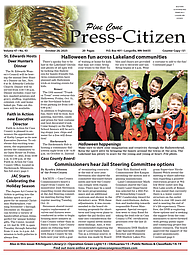May 31, 2025 at 1:40 p.m.
Outdoors - Controlled Burn
When my son, Damon, first suggested we do a burn in a patch of timber, I thought he was crazy. I could only imagine the brush, grass, and trees all burning in a monumental conflagration leaving a vast blackened scar like a person sees in the western states after a forest fire. He assured me, this would not be the case. I had my doubts but agreed to give it a try on a spring day when the wind was not blowing.
There are several compelling reasons to do a controlled burn. The main reason we wanted to do it was to control noxious weeds, such as multiflora rose and insects, primarily ticks. Burning also gets rid of dead trees and blown down branches giving space for new trees to grow.
Last year, before the trees started to leaf out or ground nesting birds had begun to lay eggs, we decided on a patch of timber of about twenty acres to give it a try. On a Saturday morning, we decided to give it a go. It had not rained for several days and the wind was calm. The prescribed area had trails around and through the timber where we could make fire breaks. Armed with a drip torch to start the fire, chain saws, shovels, and two leaf blowers, we headed into the timber. We burned the entire perimeter of the wooded area and let the fire burn toward the center. The fire surprised us when it got going. Rather than a roaring blaze, the flames moved slowly across the forest floor burning leaves and branches. If the fire tried to cross a break, the leaf blowers quickly confined it. Occasionally, a standing dead tree would catch on fire making a hot flaming torch in the middle of the timber but did not spread to nearby trees.
By the end of the day, all the leaves and brush had burnt. The forest floor was black except for a few patches of glowing embers, the remains of dead fallen trees. Within a week, grass was starting to grow where only leaves and rose bushes had been. A month later, new trees were sprouting. By mid-summer, I was astounded by the improvement in the burned area. Most of the rose bushes were dead and oak and hickory trees were shooting up.
Being encouraged by the prior results, this year, over several weekends, we burnt over a hundred acres. It gets to be a lot of work, and a person needs to create a strong fire break surrounding the burn area. As it is burning, a person must monitor the progress continuously. In my opinion, the work is well worth the effort. The improvement to the timber is dramatic. Chances of an accidental fire starting and being out of control are greatly reduced. Biodiversity is increased and wood tick populations are decreased.
I was concerned about the effect the fire would have on the wildlife in the area. Deer and turkeys moved out for a day or two and returned to find acorns and hickory nut exposed and ready to eat. Birds left for the day but were back by the next morning.
When we burned again this year, we again burned the twenty acres we had done the prior year. From lack of fuel of leaves and downed branches, it did not burn as well or make such a dramatic improvement. From our experience, I would say burning an area every two or three years would be adequate. We will be doing a long-range plan of using controlled burns for forest improvement.
WEATHER SPONSORED BY
Latest News
Events
November
To Submit an Event Sign in first
Today's Events
No calendar events have been scheduled for today.

Comments:
You must login to comment.